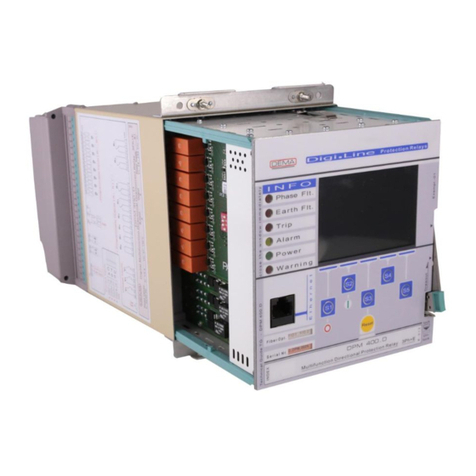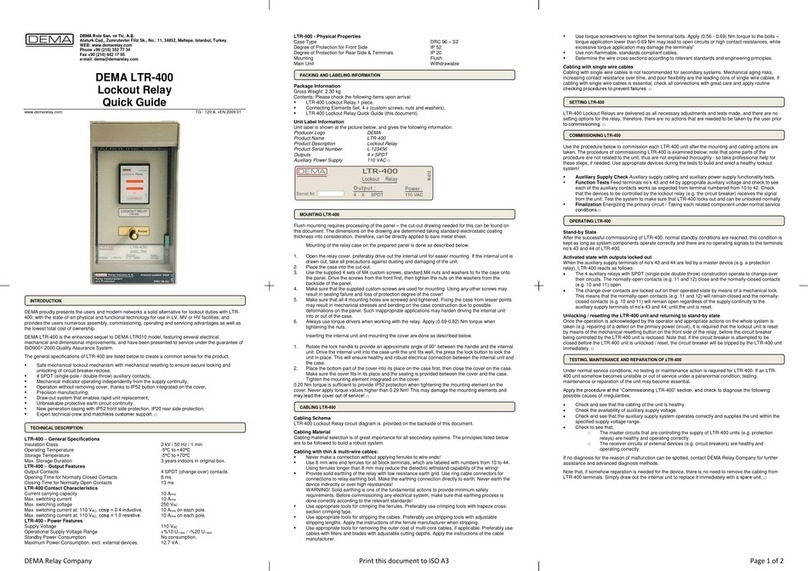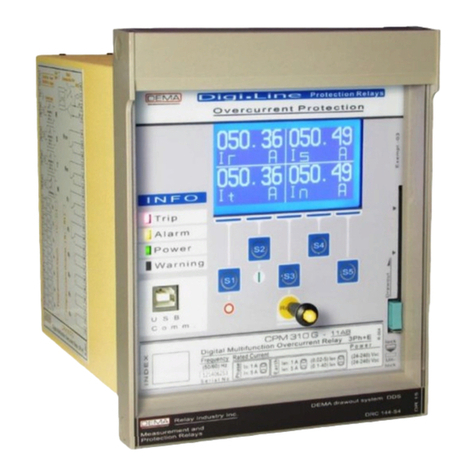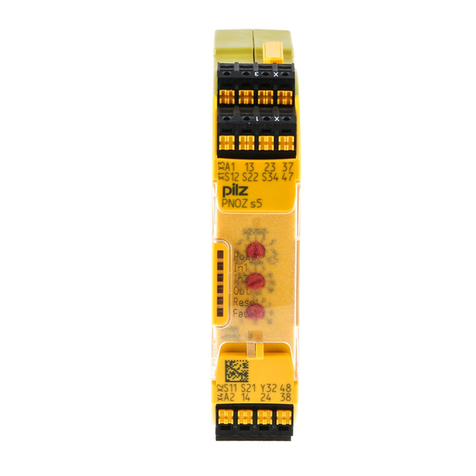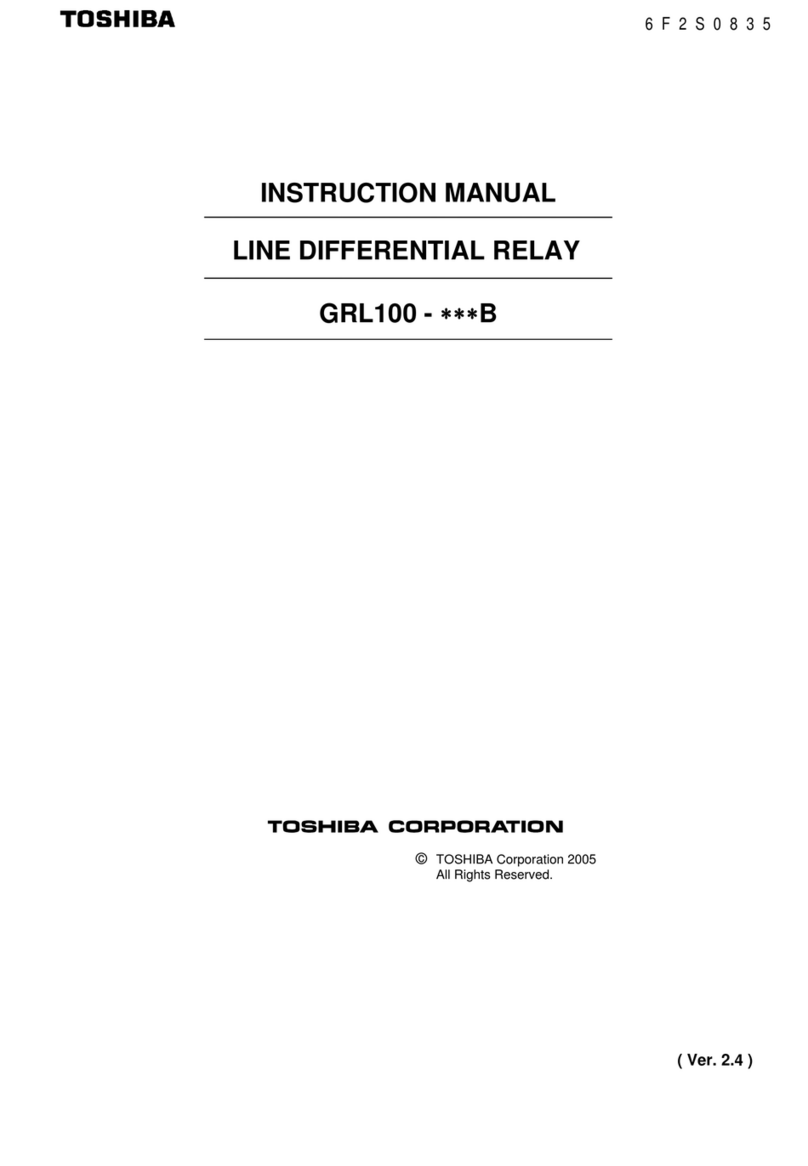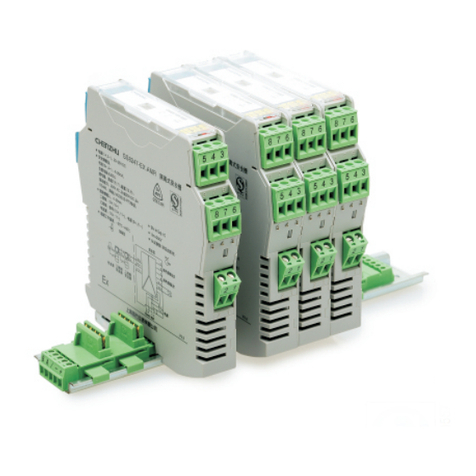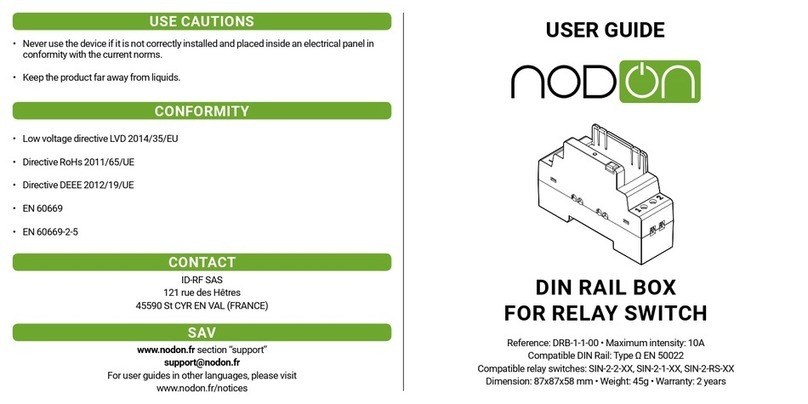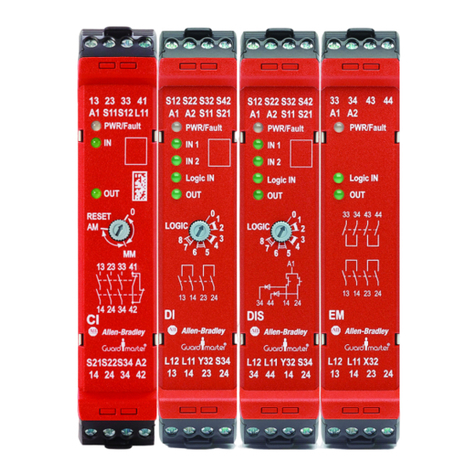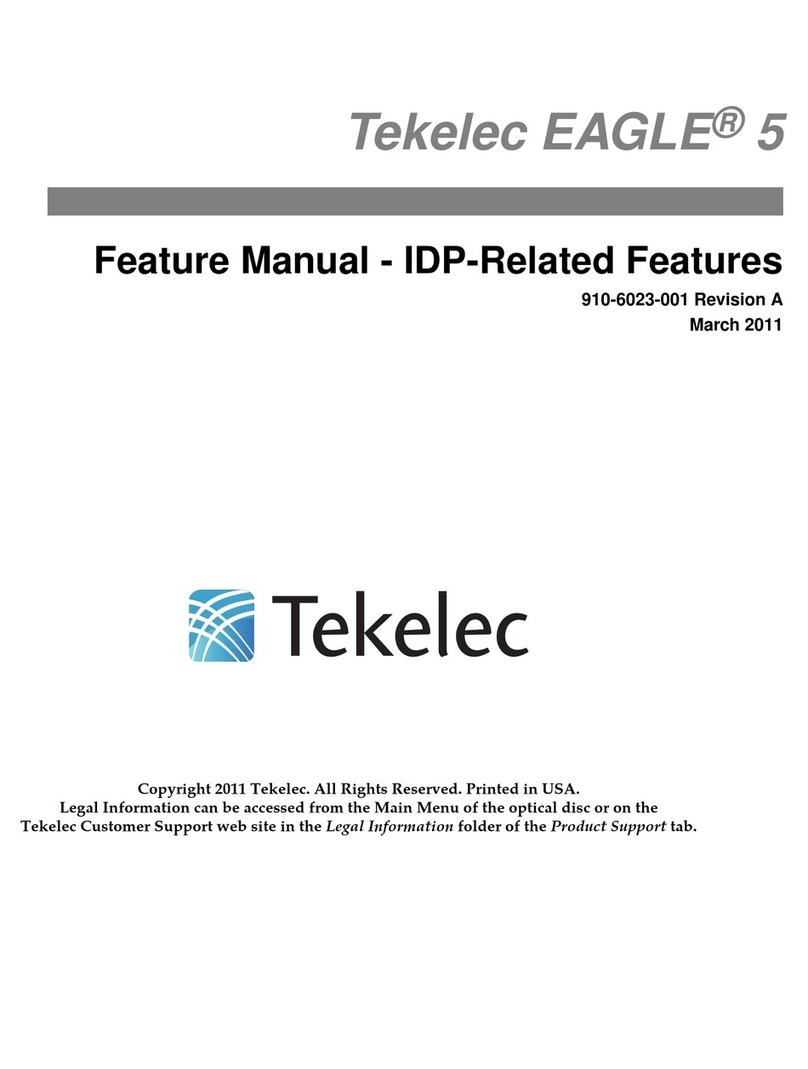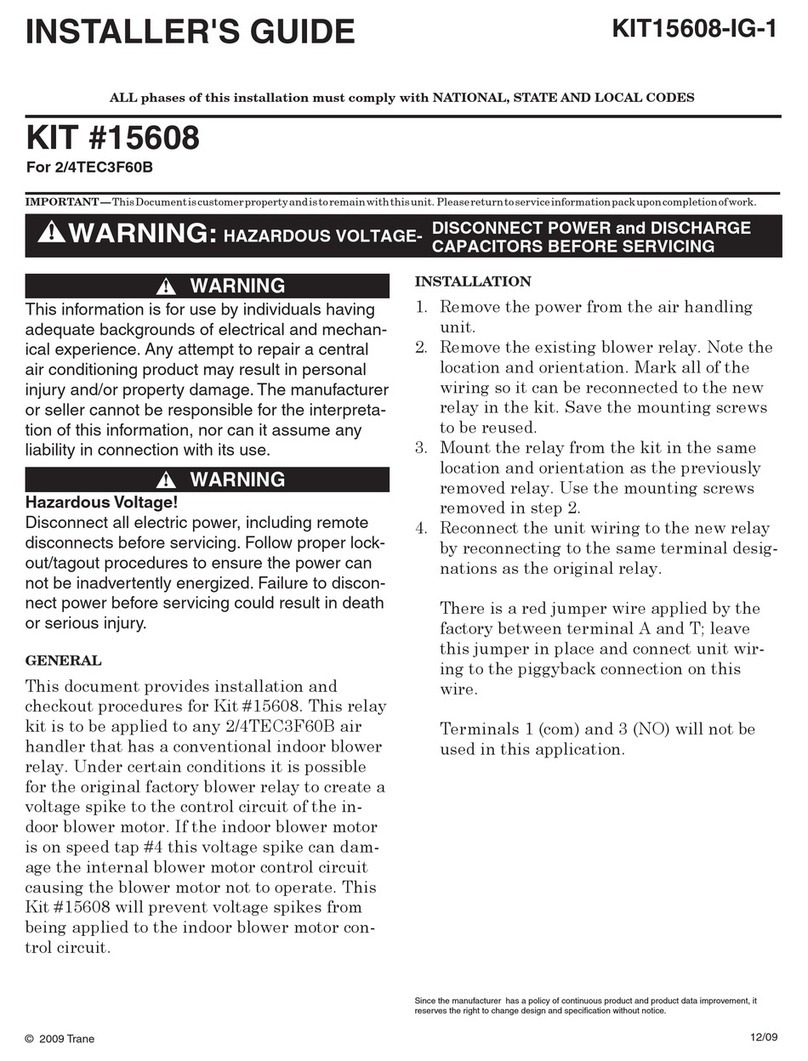DEMA CPM 311 User manual


- 2 -
1. About DEMA p.6
1.1. General Information p.7
1.2. Product Range p.9
1.3. Contact Us p.10
2. Introduction p.11
2.1. General Specifications & Advantages p.12
2.2. Physical Introduction p.14
2.3. Protection and Reset Curves p.22
2.3.1. IEC Protection Curves p.23
2.3.2. IEC Thermal Overload Protection Curve p.25
2.3.3. ANSI / IEEE Protection Curves p.26
2.3.4. Custom Protection Curves p.28
2.3.5. DMT: Definite Minimum Time Characteristic p.30
2.3.6. RIDMT: Reset Inverse Definite Minimum Time Characteristics p.31
3. Packing & Labeling Information p.32
4. Operating Manual p.34
4.1. General Principles p.35
4.2. Mounting p.36
4.2.1. Panel Cut-out p.36
4.2.2. Mounting the Case p.37
4.2.3. Mounting the Inner Unit and the Cover p.37
4.3. Cabling p.38
4.3.1. Cabling Diagram p.38
4.3.2. Cabling Material p.42
4.4. Setting p.43
4.4.1. Example Setting and Calculation p.44
4.4.2. Dip-switch Settings p.47
4.4.3. Example Dip-switch Settings p.49
4.4.4. Warnings p.49
4.5. Commissioning p.50
4.6. Operating p.51
4.6.1. Normal Operation p.51
4.6.2. Fault Diagnosis and Maintenance p.51
4.6.3. Recommissioning p.51
4.7. Testing & Maintenance & Reparation p.52
5. Relay Menus Manual p.53
5.1. Introduction p.54
5.2. The Menu Tree p.55
5.3. Reset Menu p.62
5.4. Circuit Breaker Monitoring and Control Menu p.64
5.5. Settings Group Selection Menu p.65
5.6. Protection and Control Settings Menu p.66
5.6.1. I> Phase Overcurrent 1st Threshold Protection Menu p.67
5.6.2. I>> Phase Overcurrent 2nd Threshold Protection Menu p.68
5.6.3. I>>> Phase Overcurrent 3rd Threshold Protection Menu p.69
5.6.4. Ie> Earth Overcurrent 1st Threshold Protection Menu p.70
5.6.5. Ie>> Earth Overcurrent 2nd Threshold Protection Menu p.71
5.6.6. Ie>>> Earth Overcurrent 3rd Threshold Protection Menu p.72
5.6.7. I2> Negative Sequence Overcurrent 1st Threshold Protection Menu p.73

- 3 -
5.6.8. I2>> Negative Sequence Overcurrent 2nd Threshold Protection Menu p.74
5.6.9. %(I2/I1)> Broken Conductor Protection Menu p.75
5.6.10. I< Phase Undercurrent Protection Menu p.76
5.6.11. IΘ> Thermal Overload Protection Menu p.77
5.6.12. Auto-recloser Settings Menu p.80
5.7. Main Menu p.83
5.7.1. Measurement Menu p.85
5.7.1.1. RMS Current and Frequency Measurements Menu p.86
5.7.1.2. Max RMS Current Measurements Menu p.87
5.7.1.3. Fundamental Harmonics Measurements Menu p.88
5.7.1.4. Positive and Negative Sequence Current Measurements Menu p.89
5.7.1.5. Thermal Θ Measurements Menu p.90
5.7.1.6. Input & Output Status Monitoring Menu p.91
5.7.1.7. Circuit Breaker Measurements p.92
5.7.1.8. Auto-recloser (ARCL) Measurements Menu p.93
5.7.2. Communication Settings Menu p.94
5.7.3. Event Records Menu p.95
5.7.4. System Settings Menu p.96
5.7.5. Current Transformer Settings Menu p.99
5.7.6. Automatic Control Settings Menu p.101
5.7.6.1. Cold Load Pickup Settings Menu p.102
5.7.6.2. Output Relay Settings Menu p.104
5.7.6.3. Trip Settings Menu p.105
5.7.6.4. Input Settings Menu p.106
5.7.6.5. Blocking Logic Selectivity Settings Menu p.107
5.7.6.6. Circuit Breaker Failure Recognition Settings Menu p.110
5.7.6.7. Auxiliary Timer Settings Menu p.112
5.7.6.8. Delaying Logic Selectivity Settings Menu p.113
5.7.6.9. Auto-recloser (ARCL) Settings Menu p.114
5.7.6.10. CB Supervision Settings Menu p.117
5.7.6.11. Programmable LEDs Settings Menu p.120
5.7.6.12. Latching Settings Menu p.122
5.7.6.13. Alarm Settings Menu p.124
5.7.7. Function Test Menu p.125
5.7.8. Fault Records Menu p.126
6. DigiConnect PC Program Manual p.127
6.1. Operating System & Hardware Requirements p.128
6.2. Program Setup p.129
6.3. Program Start-up p.132
6.4. Software Introduction and Guide p.135
6.4.1. Welcome Screen p.136
6.4.2. Measurements p.137
6.4.2.1. Analog Values p.137
6.4.2.1.1. RMS Current p.137
6.4.2.1.2. Fundamental Harmonics p.138
6.4.2.1.3. P/N Sequences p.139
6.4.2.1.4. Max. RMS Current p.140
6.4.2.2. Circuit Breaker Measurements p.141
6.4.2.3. ARCL Measurements p.142
6.4.2.4. Remote Control p.143
6.4.3. Alarms / Event Records Menu p.144
6.4.3.1. Alarms p.144
6.4.3.2. Event Records p.145
6.4.3.3. Trip Records p.146
6.4.4. Settings Menu p.147
6.4.4.1. Protection Settings p.148

- 4 -
6.4.4.1.1. Phase Protection Settings p.150
6.4.4.1.2. Earth Protection Settings p.151
6.4.4.1.3. Broken Conductor Protection Settings p.152
6.4.4.1.4. Negative Sequence Protection Settings p.153
6.4.4.1.5. Thermal (Overload) Protection Settings p.154
6.4.4.2. CT Settings p.155
6.4.4.3. System Settings p.156
6.4.4.4. Automatic Control Settings p.157
6.4.4.4.1. Input Settings p.158
6.4.4.4.2. (Auxiliary) Timer Settings p.159
6.4.4.4.3. Output Relay Settings p.160
6.4.4.4.4. Trip Settings p.161
6.4.4.4.5. Blocking (Logic) Selectivity Settings p.162
6.4.4.4.6. CB Failure Settings p.163
6.4.4.4.7. Delaying (Logic) Selectivity Settings p.164
6.4.4.4.8. Auto Recloser Settings p.165
6.4.4.4.9. Cold Load Pickup Settings p.167
6.4.4.4.10. CB Supervision Settings p.168
6.4.4.4.11. (Programmable) LED Settings p.169
6.4.4.4.12. Latch Settings p.170
6.4.4.4.13. Alarm Settings p.171
6.4.4.5. Communication Settings p.172
6.4.5. Buffer Menu p.173
6.4.6. Disturbance (Waveform) Records Menu p.179
7. Application Diagrams p.188
7.1. On the Use of Application Diagrams p.189
7.2. Sample Application p.189
7.3. Fundamental Cabling Diagram p.192
7.4. Application Diagram No.1 p.193
7.5. Application Diagram No.2 p.194
7.6. Application Diagram No.3 p.195
7.7. Application Diagram No.4 p.196
7.8. Application Diagram No.5 p.197
7.9. Application Diagram No.6 p.198
7.10. Application Diagram No.7 p.199
7.11. Application Diagram No.8 p.200
7.12. Application Diagram No.9 p.201
7.13. Application Diagram No.10 p.202
8. Technical Diagram p.203
8.1. USB Connection Cable p.204
8.2. Technical Drawings p.205
8.3. Technical Specifications p.206
8.4. Default Settings p.213
8.5. Type Tests p.217
8.6. Ordering Codes p.218
9. Glossary p.219

- 5 -
DEMA Role San. ve Tic. A. S. is a secondary protection relays
and accessories manufacturer carrying out its activities in a
plant with 2000 m² closed area in Maltepe, Istanbul, Turkey.
The plant itself inspires creativity and innovation by its high-
tech infrastructure, laboratory-clean environment and the art
collection it hosts.
DEMA Role San. ve Tic. A. S. has manufactured over 100,000
pieces of protection units since its foundation in 1977, and has
great reputation among its clients.
The innovations history of DEMA is as follows:
•1977 - R3AS20E: The first DMT electromechanical overcurrent protection relay in the country,
•1985 - R1TA112: The first draw out type electromechanical overcurrent protection relay in the country
with IDMT delay,
•1990 - R1SA01: The first draw out type electromechanical earth fault protection relay in the country with
DMT delay,
•1990 - R1ST04: The first draw out type electromechanical thermal overload protection relay in the country
with thermal image display,
•1997 - MCR Series: The first draw out type electronic overcurrent protection relay series in the country
with DMT and IDMT delay,
•1997 - MVR Series: The first draw out type electronic over/undervoltage protection relay series in the
country with DMT and IDMT delay,
•2000 - IR1021: Double-flashing annunciator relay with
LEDs,
•2006 - CPM Series: The first draw out type DSP-based
digital overcurrent protection relay with digital communication
and LCD display features.
•2011 - CPM 311: The first digital relay with separate
control and main units.
DEMA Role San. ve Tic. A. S. invests more than 10% of its total
revenue into R&D projects, which clearly demonstrates DEMA’s
commitment into innovation.
The R&D philosophy of DEMA focuses particularly on user-
friendliness, assurance of high-quality, reliability and
international standards compliance of its products.
A good example on the outcomes of DEMA’s R&D philosophy is
the innovative features of CPM 310 series digital overcurrent
protection relays –a product which introduced the most user-
friendly interface yet by employing the mobile phone
navigation technology into protection relays era.
Some other innovations are as follows:
•The most secure secondary shorting mechanism on
the world yet, which enables under-load replaceability of
overcurrent protection units more safely than ever,
•Withdrawable unit locking mechanism,
Employment of high-frequency band measurement
transformers in protection relays.

- 6 -
The molding workshop of DEMA is one of the most advanced
facilities in its sector. The workshop
•Works only for prototyping,
•Or production molding construction for DEMA
products.
The molding workshop hosts
•Wire erosion machines,
•Through erosion machines,
•Erosion drills,
•Taşlama,
•And CNC systems worthing over 3,000,000 USD of
investment into production precision.
All of the metal, plastic, electro-mechanical and graphical
components used in DEMA’s products are designed, prototyped
and manufactured in the same facility by DEMA engineers and
technicians.
50% of DEMA’s total revenue comes from international sales
with an increasing proportion. DEMA imported to over 10
countries all over the world in 2009.
The innovative and leading policy of DEMA has been recognized
and awarded by many national titles in the past years. DEMA
promises its clients better solution partnership and wider range
of high quality products in the future, just as provided in the
past.

- 7 -
1. DSP-based Digital Protection Relays
CPM 310 G Three phase + earth overcurrent protection relay with draw-out system.
CPM 311 Three phase + earth overcurrent protection relay with seperated units.
2. Microprocessor-based Protection Relays
MCR 010 1-module earth overcurrent protection relay in draw-out case.
MCR 100 1-module phase overcurrent protection relay in draw-out case.
MCR 210 3-modules 2 phase + earth overcurrent protection relay in draw-out case.
MCR 300 3-modules 3 phase overcurrent protection relay in draw-out case.
MCR 310 4-modules 3 phase + earth overcurrent protection relay in draw-out case.
MVR 100 1-module over/undervoltage protection relay in draw-out case.
MVR 200 2-modules over/undervoltage protection relay in draw-out case.
MVR 300 3-modules over/undervoltage protection relay in draw-out case.
MVR 400 4-modules over/undervoltage protection relay in draw-out case.
3. Annunciating System Components
IT1-6 6-windows optical annunciator.
K 101 - A2 Multitone acoustic horn / annunciator.
KR30 Horn Relay.
IR61K-A2 6-windows optical annunciator with relay and horn outputs in draw-out case.
IR101K-A2 10-windows optical annunciator with relay and horn outputs in draw-out case.
IR1021 10-windows double-flashing optical annunciator with relay and horn outputs in
draw-out case.
4. Auxiliary Devices
KAC Capacitor-based auxiliary supply unit.
GKR15 DC auxiliary supply supervision relay.
RY600 Auxiliary relay
ZR20 On-delay auxiliary time relay.
ZR25 Off-delay auxiliary time relay.
BR25 Flash relay
WR25 Impulse relay.
LTR-400 Lock-out relay.
For detailed information on products; please see our WEB site at www.demarelay.com, or contact us using the
information in the Contact Us section on the next page. □

- 8 -
Address DEMA Role San. ve Tic. A. S.
Zumrutevler Mh. Ataturk Cd. Inanc Sk.
No.: 4, 34852,
Maltepe, Istanbul, Turkey.
Phone +90 (216) 352 77 34
+90 (216) 352 77 35
Fax +90 (216) 442 17 95
E-mail [email protected]
WEB www.demarelay.com
□
DEMA Role San. ve Tic. A. S. Plant at Istanbul, Turkey.

- 9 -
INTRODUCTION

- 10 -
DEMA proudly presents the users and modern networks a solid alternative for overcurrent protection
with CPM 311; with the state-of-art electronic, physical and functional technology for use with (X/5) A
or (X/1) A conventional type current transformers. As a DSP based digital multi-function protection &
control relay with 3 phase & earth overcurrent protection, DEMA CPM 311 is tested to fulfill
international standards requirements; and provides the users numerous assembly, commissioning and
service advantages, thanks to its separated construction (as control unit and main unit) that
eliminates the need to extend the secondary, auxiliary and control cabling to the panel door.
DEMA CPM 311 Digital Overcurrent Protection Relays are designed to protect electrical facilities
against phase and earth faults. These relays provide phase & earth overcurrent and thermal overload
protection for overhead lines, underground cables, power transformers, generators and high-power
motors; while providing selectivity with various methods. These features of DEMA CPM 311 provide
highest degree of protection while ensuring maximum availability.
DEMA CPM 311 Digital Overcurrent Protection Relays are type tested in internationally accredited
laboratories to comply with IEC 60255, IEC 60529, IEC 60695 and IEC 60068 standards, and have
been introduced into service under the guarantee of ISO9001:2008.
The general specifications of CPM 311 are listed below to create a common sense for the product. □
Function
ANSI Code
CPM 311
Phase Overcurrent Protection –Instantaneous
50
3 thresholds
Phase Overcurrent Protection –Delayed
51
3 thresholds
Earth Overcurrent Protection –Instantaneous
50N
3 thresholds
Earth Overcurrent Protection –Delayed
51N
3 thresholds
Thermal Overload Protection
49
2 thresholds
Phase Undercurrent Protection
37
1 thresholds
Negative Sequence Overcurrent Protection
46
2 thresholds
Output Latching
86
✓
Circuit Breaker Failure Detection
50BF
✓
Auto –Reclosing
79
4 shots
Thermometer –Buchholz Protection
26 / 63
✓
Broken Conductor Protection
✓
Cold Load Pickup
✓
Protection and Settings Groups
2 groups
Circuit Breaker Trip Circuit Supervision
TCM
✓
Circuit Breaker Monitoring and Control
✓
Blocking Logic Selectivity
68
✓
Delaying Logic Selectivity
✓
Circuit Breaker Remote Control
94
✓
5 inputs and 4 outputs
✓
Disturbance Waveform Recording
3 x 5 s
Event & Fault Recording
SER
150 records
USB & RS485 Communication Ports
✓
X/1 A & X/5 A CT Compatibility
✓
Frequency, Current and Thermal Imaging Measurements
✓
Positive & Negative Sequence Current Measurements
✓
Phase Rotation Monitoring
✓
Auto-reclosing Measurements
✓
Self-check
✓
Protection Functions Testing
✓

- 11 -
▪Wide IEC, ANSI and custom delay curve support, enabling selectivity setup with all types of
protection relays including electromechanical relays,
▪DMT and IDMT delay curve support for all overcurrent protection functions,
▪Remote control and monitoring of the circuit breaker via dedicated menu with mimic diagram,
▪Annunciating functions and 5 optically coupled programmable inputs that eliminate the need to
use external annunciators (e.g. to evaluate Buchholz, temperature and pressure signals),
▪Buchholz & thermometer alarm & trip functions and pressure trip functions that can be appointed
to programmable inputs & outputs & LEDs,
▪4 outputs: Trip (SPDT) and watchdog (SPDT) plus 2 programmable outputs (2 SPST),
▪Full screen R –S –T and N ampermeter display, measurement functions that eliminate the need
to use double core CTs, external ampermeter and frequency-meters,
▪(X/1) A and (X/5) A current transformer compatibility in a single unit,
▪Wide setting ranges; (0.1-40) Incurrent setting range, (0.01-150) s DMT delay setting range,
(0.025-3.2) IDMT (TMS & RTMS) delay setting range,
▪2 independent settings groups,
▪3 independent thresholds for phase overcurrent protection,
▪3 independent thresholds for earth overcurrent protection,
▪2 independent thresholds for negative sequence overcurrent protection,
▪1 independent threshold for undercurrent protection,
▪Thermal overload protection with thermal image according to IEC 60255-8 ed.2.0,
▪Auto-recloser with 4-shots, auto-reclosing programmability for each protection function,
▪Cold-load pickup function with high reliability CB-triggering,
▪Blocking logic selectivity feature,
▪Delaying logic selectivity feature,
▪Circuit breaker failure supervision and alarming,
▪Circuit breaker supervision functions: opening and closing time supervision; charging spring
supervision; numerator, ΣA and ΣA² supervision for each pole; trip circuit supervision,
▪Main menu that displays the activated protection functions so as to provide quick overview by the
user,
▪2 level password system to provide access security to settings menus and remote CB control
menu,
▪Quick alarm menu access and enhanced alarm explanations with manual and automatic alarm
resetting option,
▪8 programmable alarm LEDs,
▪Event and fault records up to 150 instances,
▪5 waveform records with 3 seconds duration each,
▪Electro-magnetic compatibility tested to satisfy related IEC directives,
▪Separated construction (as control unit and main unit) that eliminates the need to extend the
secondary, auxiliary and control cabling to the panel door,
▪Protection function testing feature for checking the fundamental cabling and settings without need
to use external testing devices,
▪Largest LCD graphics screen in its class (128 px x 64 px); easy-to-navigate user friendly menus
similar to mobile phones’,
▪Auxiliary supply voltage compatibility with all voltages in the field;
Uaux = (21 –250) VDC / (100 –250) VAC,
▪IP52 front side and IP20 backside environmental protection,
▪SCADA ready,
▪USB and RS485 communication ports; MODBUS RTU, IEC 60870-5-103 and DEMCOM
communication protocols support,
▪Free-of-charge PC software and accessories,
▪Matchless customer support, a variety of application schemas and technical documents. □

- 12 -
CPM 311: General Overview
•CPM 311 Control Unit
CPM 311 Control Unit is a man –machine interface unit. The unit does not have any protection
circuitry; the primary role of the unit is rather providing the accessibility to the settings,
measurements etc., which are run and stored on the main unit. The USB port needed for PC
communication is also located on the rear side of the control unit
CPM 311 Control Unit is intended to be flush –mounted on the panel door. The innovative design
of the product reduced the quantity of cables that have to be carried to the cover to only two
cables. One of them is the RJ45 terminated communication cable which enables the data
exchange between the main and control units, and the other one is the protective earth conductor
of the control unit. No other cabling is required on the panel door.
CPM 311 Control Unit can be replaced during operation, if needed. During the replacement, the
main unit functions normally, without having to interrupt the facility protection. Once the
replacement is completed, restarting the relay will provide the main unit to identify the new
control unit and start to function normally.
•CPM 311 Main Unit
CPM 311 Main Unit has the main circuitry that runs the measurement, protection, control and
recording processes. The secondary circuit terminals as well as the auxiliary supply, output, input
and RS 485 terminals are located on the bottom side of the main unit. All of the terminals
excluding the secondary circuit terminals are of plug –receptacle type, which provides easy
cabling and unit replacement.

- 13 -
CPM 311 Control Unit: Front View
•Status LEDs
4 status LEDs are located on the front side of the CPM 311 Control Unit.
oTrip: This LED reports the trip relay activity. The LED runs continuously if the trip relay is
closed at that time, and flashes if the trip occurred but the trip relay is then released.
oAlarm: This LED reports the alarming events. The LED flashes if there are new alarms on
the alarm menu that has not been viewed by any user, and starts to run continuously if
the alarms are viewed but not reset.
oPower: This LED reports the auxiliary supply status. If the auxiliary power supply is
healthy, the LED runs continuous green.
oWarning: This LED reports the internal circuitry errors by running continuous red if any
internal errors are detected.
•Phase Protection LEDs
4 phase protection LEDs are located on the front side of the CPM 311 Control Unit.
oTrip Θ: If the thermal overload protection (IΘ›) is activated, this LED will run continuously
red in case of thermal overload tripping.
oI›: If the phase overcurrent protection (I›) is activated, this LED will run continuously red
in case of phase overcurrent tripping.
oI››: If the phase short-circuit protection (I››) is activated, this LED will run continuously
red in case of phase short-circuit tripping.
•Earth Protection LEDs
4 earth protection LEDs are located on the front side of the CPM 311 Control Unit.
oIe›: If the earth overcurrent protection (Ie›) is activated, this LED will run continuously red
in case of earth overcurrent tripping.
oIe››: If the earth short-circuit protection (Ie››) is activated, this LED will run continuously
red in case of earth short-circuit tripping.
•(124 x 64) px Graphics Screen
128 px x 64 px backlit graphics display provides a large viewing area that ensures easy operation
and readability.
•Multi-functional Buttons
Similar to cell phone technology, multifunctional buttons provide easy command and navigation
between the menus. The reset button in this group provides access to the programmable LEDs
and alarms menu, lets the user to reset alarm if any available and unlatch any outputs, if
applicable.
•Unit Label
The inerasable label indicates the ordering code, serial number and other information to comply
with IEC standards.

- 14 -
CPM 311 Control Unit: Rear View
•Mounting Flanges
By plugging the mounting pieces (which comes with the unit) on the mounting flanges, the
control unit is fixed on the panel door.
•RJ45 Terminal
One end of the RJ45 terminated communication cable provided along with the product is plugged
into that terminal. The cable enables the data exchange between the main and control units.
•Ground Terminal
The protective earthing connection of the control unit is achieved via this terminal. Appropriate
cable lugs are provided within the product box.
•USB Port
USB communication port is the connection point for PC communications via DigiConnect software.
Connection cable is supplied within the product box.

- 15 -
CPM 311 Main Unit: General Overview
•Main Unit Cover Screw
The main unit cover is fixed on the base plate via this screw. In case of need (e.g. for setting the
dip-switches or replacing the fuse), the internal circuits can be reached by removing the cover
screw.
•Secondary Cabling Terminals
The CT secondary cables and the returning neutral cable are to be connected to these terminals.
The terminals feature exceptional thermal and dynamic withstand capabilities and robust contact
performance to ensure maximum operating reliability.
•Auxiliary Supply Terminals
The auxiliary supply conductors and the operating ground conductor are to be connected on these
terminals. The terminals are of plug –receptacle type.
•Output Terminals
The trip, watchdog and 2 programmable output conductors are to be connected on these
terminals. The terminals are of plug –receptacle type.
•Input Terminals
The common supply and signal conductors for the 5 programmable inputs are to be connected on
these terminals. The terminals are of plug –receptacle type.
•RS485 Port
The data cables, termination load bridge and the reference cabling are to be done on these
terminals. The terminals are of plug –receptacle type.

- 16 -
CPM 311 Main Unit: Right Side View
•Ground Terminal
The protective earthing connection of the control unit is achieved via this terminal. Appropriate
cable lugs are provided within the product box.
The case of the CPM 311 main unit is made of inoxidant metal material. This construction
functions as a Faraday cage around the main circuits, filtering any electromagnetic and electrical
disturbances that may otherwise impact the healthy operation of the relay. Just like any other
electrical appliance, solid grounding of the main unit is essential to provide maximum protection
for the operators and the relay.
•RJ45 Terminal
One end of the RJ45 terminated communication cable provided along with the product is plugged
into that terminal. The cable enables the data exchange between the main and control units.

- 17 -
CPM 311 Main Unit: Internal Overview
•Dip-switch Group
CPM 313 Digital Overcurrent Protection Relays can operate with X/1 A or X/5 A current
transformers. The dip-switches shown on the image above enables the setting of the relay to
work with X/1 A or X/5 A current transformers. The dip-switches are used also for earth fault
protection setting range.
•Current Transformers
These high-technology CTs transform secondary current into useful signals to provide the
measurement and protection circuits with the information they need. Current transformers are
integrated into the internal unit –this guarantees fast maintenance and replacement operations
without having to carry out calibration procedures.
•Fuse Holder
The T1A fuse protecting the main unit circuits is mounted on this fuse holder. The fuse ensures
the protection of the circuits in case of any auxiliary supply faults and provides maximum service
continuity. The placement of the fuse holder enables quick access and fast replacement of the
fuse.
•Real-time Clock Battery
Real-time clock is run by the auxiliary supply power while the relay is in service; in case of
auxiliary supply shortage or internal unit drive out, real-time clock battery takes the duty over.
Life expectancy of the lithium-ion battery is 10 years under normal conditions. □

- 18 -
X/1 A & X/5 A CT Compatibility
CPM series relays are suitable for
use with conventional X/1 A and
X/5 A current transformers. By
making appropriate settings on
the dip-switch group on the
internal unit, the secondary
nominal current can be changed
as In= 1 A or In= 5 A within
seconds.
Phase & Earth Fault
Instantaneous Protection
(ANSI 50 / 50N)
There are 3 thresholds for
instantaneous phase & earth
fault protection. The setting
zones are given below.
For phase protection:
I›= (0.1 - 25) In
I›› = (0.5 - 40) In
I››› = (0.5 - 40) In
There are two setting zones for
earth fault protection. These are
available via appropriate dip-
switch settings on the internal
unit, and have the following
setting zones:
For T1 earth fault protection:
Ie›= (0.1 - 25) Ien
Ie›› = (0.5 - 40) Ien
Ie››› = (0.5 - 40) Ien
For T2 earth fault protection:
Ie›= (0.02 - 5) Ien
Ie›› = (0.02 - 5) Ien
Ie››› = (0.02 - 5) Ien
Phase & Earth Fault Delayed
Protection (ANSI 51 / 51N)
DEMA CPM 311 provides a large
variety of protection curves for
delayed phase & earth fault
protection. These curves consist
of standard IEC/ANSI curves,
definite time delay (DMT) as well
as custom curves that are
compatible with
electromechanical relays. To
help the users apply flexible and
precise settings, these curves
feature a large setting zone with
relatively small steps. The
resetting delay setting zones are
likewise flexible and precise.
Thermal Overload Protection
(ANSI 49)
Best protection for power
transformers, overhead lines and
underground cables at loads
around (100 –150) % is
provided by thermal overload
protection schemes. Unlike the
overcurrent curves, the thermal
overload protection curve
delivers relatively longer delays
to provide maximum power
availability, while preventing
excessive thermal stresses on
the protected equipment by
utilizing thermal imaging
technology. By applying
appropriate combination of
thermal overload and phase
overcurrent functions, it is
possible to achieve the optimal
protection, selectivity and power
availability solutions. In addition
to the automatic protection
function, the thermal stress on
the equipment is monitored in
real time for checking on
demand. It should be noted that
the thermal overload protection
function fulfills the requirements
of the IEC 60255-8 standard.
Phase Undercurrent Protection
(ANSI 37)
This function is used in
applications where undercurrent
monitoring is required (e.g.
tripping of a contactor
controlling a water pump when
the water source is exhausted).
The function requires a 52a
(normally open contact) signal
for reliable operation. Setting
zone is I‹ = (0.02 - 1.0) In.
Negative Sequence Overcurrent
Protection (ANSI 46):
Unbalanced phase current
conditions without earth faults
on the primary circuit of a
distribution line or unbalanced
current conditions with or
without earth faults on the
secondary circuit of a power
transformer can be detected and
intervened by this function. The
delaying options are the same
with phase overcurrent
protection function.
Output Latching (ANSI 86)
CPM 311 allows users to latch
the trip output relay and the 2
programmable output relays on
demand. The latching settings
menu on the relay allows
independent latching control for
the mentioned 2 outputs.
Unlatching of the outputs is
available via the reset button or
an external signal to an
appropriately programmed input.
Circuit Breaker Failure Detection
(ANSI 50BF)
This function checks to see if
any poles of a circuit breaker
fails to interrupt the primary
circuit current when tripped. If
such case is detected, the alarm
menu notices the user about the
fault and the logic signal to an
upstream relay is removed, if
applicable. The process starts
with the opening of the CB; if
the current measurements from
one or more poles of the CB do
not fall below the defined level
of detection, then the fault is
diagnosed. After a defined delay,
the alarm is given and an output
reacts, if programmed so. In
applications where blocking or
delaying logic selectivity
schemes are utilized, the logic
signal to the upstream relay is
removed by means of this
programmed output.
Auto-reclosing (ANSI 79)
The auto-reclosing function that
CPM series relays feature allows
the users to auto-reclose the CB
up to 4 shots. The auto-reclosing
behavior of CPM 311 can be
customized for all phase and
earth protection functions and
auxiliary timers, independently of
each other. The inhibit time, the
dead time and the delays
between the auto-reclosing shots
can be independently set. The
advanced auto-reclosing
algorithm of CPM 311 ensures
the safety of the system by
blocking the auto-reclosing
function in certain cases, such as
the manual operation of the CB,
detection of a fault current
within the inhibit time, and
detection a CB failure.

- 19 -
Broken Conductor Detection
The current faults in a
distribution system are easily
detected and cleared by
protection relays. However,
faults without overcurrent such
as:
•breaking of an overhead
line jumper,
•single phase fuse blow,
•closing failure of one of the
poles of a CB,
•conducting problems of a
primary power equipment,
•or open circuit on one of
the current transformer
secondary circuits introduce
dangerous and intolerable
conditions where different
methods of protection should be
utilized. The broken conductor
detection function on CPM 311
calculates the ratio between the
negative sequence current and
positive sequence current to
sense and intervene these kinds
of problems reliably, even at
relatively low current signal
levels from the healthy phases.
The function behavior can be
modified by setting the critical
ratio threshold and the delay.
Cold Load Pickup
The cold load pickup function
provides the chance to shift the
threshold values of the phase &
earth & negative sequence
overcurrent protection functions
temporarily when the circuit
breaker closes to drive cold loads
such as high power motors,
capacitor banks and power
transformers. The shifting ratio
can be set within the zone (20-
500) % by 1 % steps, while the
duration of this temporary state
can be determined between 0.1
s and 3,600 s by 0.1 s steps. The
function resolves the pickup
problems by shifting any
independent thresholds desired
and leaving others unchanged,
while blocking none. The cold
load pickup function is triggered
by means of activation of a
programmed input over one of
the auxiliary contacts of the CB /
contactor, or by a signal from an
external device; thus, the risks
of triggering by primary events
which some other algorithms
suffer are removed.
Settings Groups
In open ring distribution
systems, the setting values of a
protection relay are closely
related to the power flow
direction at the point the relay is
operated. Meanwhile, the time to
change these settings when the
power flow direction is to be
altered under a force major is
scarce. Taking these into
account, the CPM 311 relay
features 2 settings groups that
can handle 2 completely
independent sets of values of
protection and automatic control
functions that would save
valuable time for the user while
switching to the suitable settings
in a new condition. Altering
between the settings groups can
be done manually on the control
panel, via remote control over
communication systems or by
means of triggering of a
programmed input.
Circuit Breaker Trip Circuit
Supervision (ANSI TCM)
The trip circuit of a circuit
breaker comprises the trip coil,
the trip output of a relay and the
cabling between them. An open
circuit on one of these
components would prevent the
correct operation of the CB when
needed. CPM series relays are
capable of supervising the
condition of the trip circuit
continuously by one of the
programmable inputs. In the
case an open circuit is detected,
the user is noticed about the
situation by the alarm signal on
the control panel, and if desired,
remotely by means of a
programmed output.
Circuit Breaker Supervision and
Control
CPM series relays have built-in
CB supervision and control
functions that manage the
essential values and statistics to
keep track of the CB condition.
•The last opening and closing
times of the CB,
•The total opening number of
the CB,
•And the ΣA and ΣA² values
(pole condition)
are continuously supervised by
the function to notice the user in
abnormal or critical conditions by
means of local and / or remote
alarming.
Blocking Logic Selectivity
(ANSI 68)
CPM 311 supports the blocking
logic selectivity scheme. This
scheme is to be applied on
networks where power flow is
unidirectional.
When this scheme is applied,
each of the relays on a series
primary line blocks the next
upstream relay by means of
sending a blocking signal to their
programmed input, blocking and
preventing the latter to react.
This circuit design leads to the
blocking of all relays but the one
closest to the fault point,
enabling total selectivity without
applying time stepping settings.
Time delayed phase & earth &
negative sequence overcurrent
protection functions and the
broken conductor detection
function can be blocked this
way.
Delaying Logic Selectivity
CPM 311 supports the delaying
logic selectivity scheme. This
scheme is to be applied on
networks where power flow is
unidirectional.
When this scheme is applied,
each of the relays on a series
primary line shifts the trip delays
of the next upstream relay by
means of sending a delaying
signal to their programmed
input, delaying the latter to
react. This circuit design leads to
the delaying of all relays but the
one closest to the fault point,
enabling total selectivity without
applying time stepping settings.
The tripping delays of the 2nd
and 3rd thresholds of the phase
& earth overcurrent protection
functions can be prolonged this
way.
Circuit Breaker Remote Control
(ANSI 94)
CPM series relays can remotely
control circuit breakers by means
of their trip relays and
programmable outputs. The CB
control can be done from the
control panel of the relay and
over the DigiConnect PC
software.

- 20 -
Inputs and Outputs
(Including ANSI 26 & 63)
CPM 311 is equipped with 5
optically isolated &
programmable inputs and 4
output relays to fulfill demanding
requirements of modern
applications. The inputs accept
any signals within the range (24
- 250 VDC) and (100 - 250 VAC).
The outputs feature 2 SPDT and
2 SPST relays, each operating
below 10 ms delays and rated 8
A / 250 VAC. Two of the outputs
are predefined as trip and
watchdog relays, and the rest
are programmable.
Disturbance Waveform
Recording
CPM series relays can digitally
save the disturbance waveforms
they measure, and the saved
files can be downloaded and
viewed over the DigiConnect
software. CPM 311 can hold up
to 5 instances of disturbance
recordings, each totaling 3
seconds of sampling with 0.4 s
predisturbance recording.
Being able to observe the
disturbance waveforms allows
users to analyze faults, confirm
the convenience of the
parameter settings, and
understand the network behavior
better.
Event and Fault Recording
(ANSI SER)
CPM series relays store up to
150 events and fault records.
The event and fault records are
time-stamped with the
information from a real-time
clock which is supplied by a
built-in extra long-life lithium-ion
battery. The records comprise
the precise timing, type and
details of the events / faults. The
records can be viewed on the
device screen as well as on a PC
utilizing the DigiConnect
software.
Communications Features
CPM series relays make use of
two serial communication ports.
•One of the ports is the hi-
speed USB port located on the
front panel of the device. The
USB port is suitable for
establishing a direct
communication link between the
device and a PC over a standard
USB cable, which is already
supplied within the product box.
Note that communication over
USB port does not require the
utilization of an adaptor, thus is
the recommended and easier
method of using DigiConnect.
•The other port is a RS485
serial communications port,
which is accessible from the
terminals at the rear side of the
device.
CPM series relays are compatible
with MODBUS RTU and IEC
60870-5-103 communication
protocols at rates between 1,200
bauds and 38,400 bauds.
Measurement Functions
CPM series relays feature the
following measurement
functions:
•Frequency measurements:
The primary circuit power
frequency once the secondary
current exceeds 0.1 In.
•Current measurements: The
momentary & maximum RMS
current values and fundamental
harmonic value of the phases
and the earth circuits.
•Positive / negative
sequence measurements:
The absolute values of positive
and negative sequence current,
and the ratio of these in
percentage.
•Thermal Θ measurements:
Thermal stress in percentage.
•Input & Output
measurements: The states of
programmable inputs and
outputs as well as the trip and
the watchdog relays.
•CB measurements: The last
opening and closing times, total
opening number, and ΣA & ΣA²
(pole condition) for each of the
circuit breaker poles.
•Auto-reclosing
measurements: All statistics and
measurements of the auto-
reclosing activity, including
number of successful auto-
reclosing cycles, and auto-
reclosing blockings.
•LED states: The momentary
states of all 8 programmable
LEDs.
Self-check & Watchdog
CPM series relays utilize a circuit
to watch over the condition of
the internal circuits and the
power supply continuity to the
device. At an instance of internal
failure or power supply shortage,
the watchdog relay reacts to
close the normally closed
contact, which is fixed at the
open state in healthy operation
conditions.
The positive operation
characteristic of the watchdog
relay therefor allows the users to
monitor the healthiness of the
protection system remotely,
using appropriate circuitry
evaluating the information from
the N/O and N/C contacts of the
watchdog relay.
Function Test
CPM series relays feature a built-
in functional test. The test is
launched manually from the
control panel. Once the test is
initiated, the digital signal
processor within the relay
produces virtual overcurrent
signals to run the protection
functions activated by the user,
leading to tripping of the circuit
breaker and termination of the
test. This test allows the users to
check the basic condition and
behavior of the protection
system elements (such as the
trip circuit cabling, the circuit
breaker and the auxiliary supply
system) without having to use
an external testing device. □
Table of contents
Languages:
Other DEMA Relay manuals
Popular Relay manuals by other brands
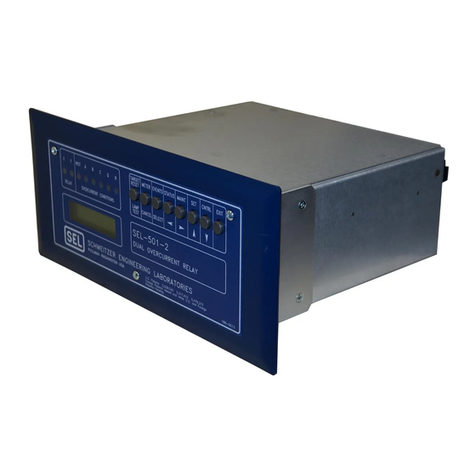
Schweitzer Engineering Laboratories
Schweitzer Engineering Laboratories SEL-501-2 instruction manual
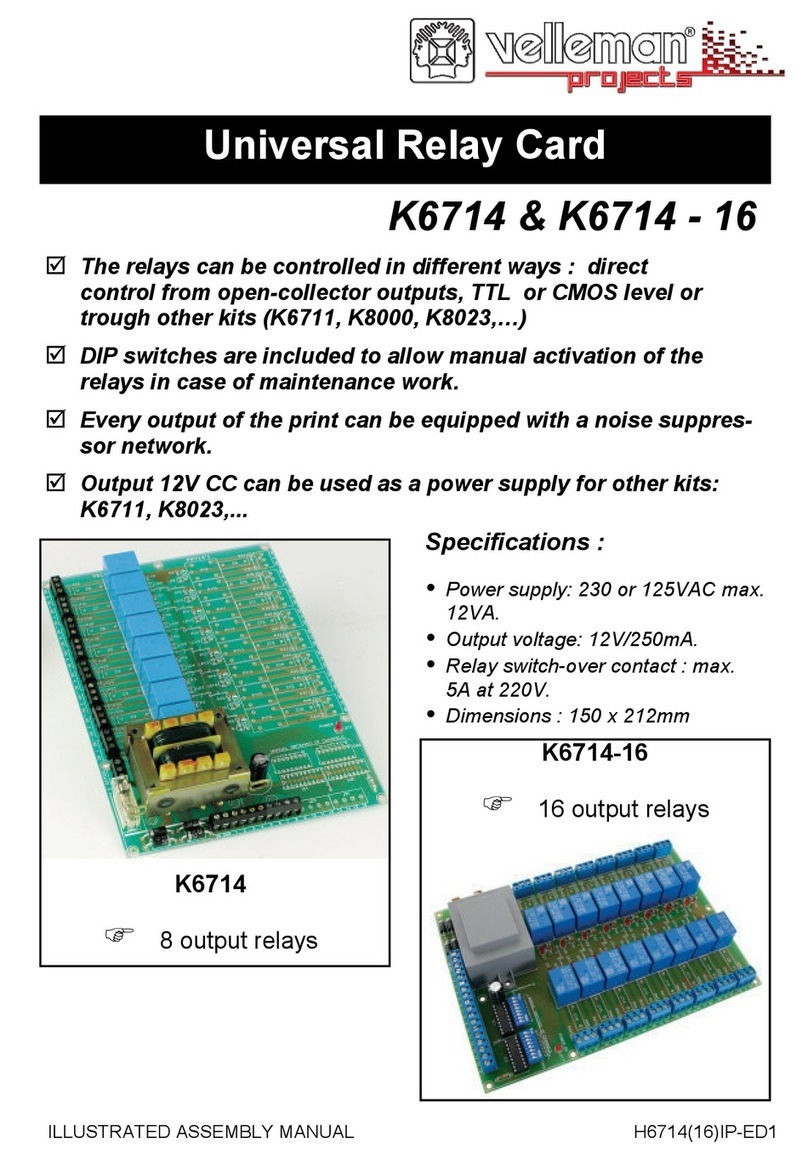
Velleman
Velleman K6714 manual
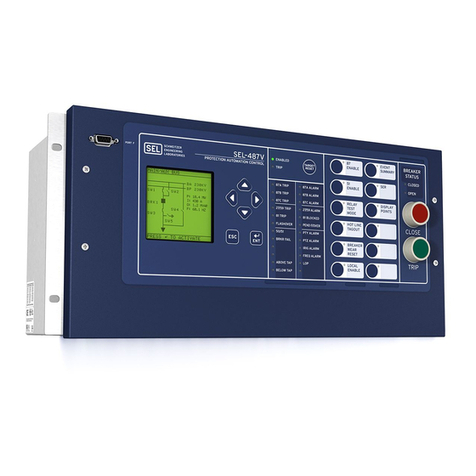
Schweitzer Engineering Laboratories
Schweitzer Engineering Laboratories SEL-487V manual
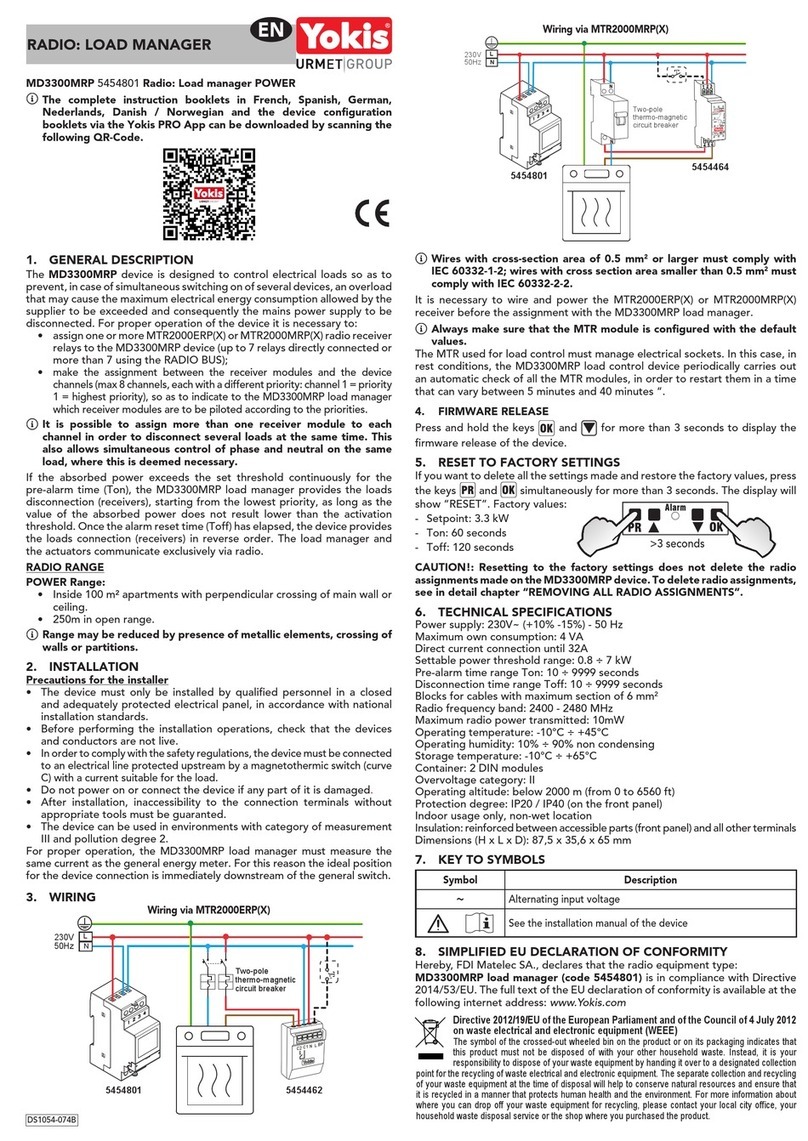
Yokis
Yokis MD3300MRP quick start guide

Pilz
Pilz PNOZ s6.1 operating instructions
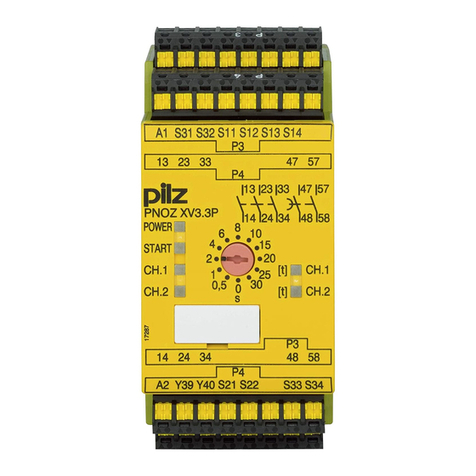
Pilz
Pilz PNOZ XV3.3P operating instructions
